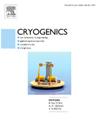AC loss and shielding in stacks of coated conductors: Analytic modelling and comparison to experiment
IF 1.8
3区 工程技术
Q3 PHYSICS, APPLIED
引用次数: 0
Abstract
This work explores the effects of the stacking of coated conductor tapes on their AC loss and penetration fields (Bp). The penetration field Bp and AC loss of short lengths of coated conducted tape stacks are analyzed, measured, and compared to a simple analytic model. The tape widths (w) and number of tapes in the stacks (Ns) were 4 mm (Ns = 1, 3, 5, series-305) and 12 mm (Ns = 1–40, series-244). Experimentally, the losses of the series-244 and series-305 tape stacks were measured in a spinning magnet calorimeter (SMC) in which the samples are exposed to a spinning field of frequency, f, up to 110 Hz and amplitude B0 = 566 mT and the power is measured by a calibrated boil-off calorimeter. These results were compared to calculated loss as a function of Ns for both tapes. In addition, the calculated Bp was plotted vs Ns. The basic effect observed was that stacking coated conductor tapes tended to form an effective composite with an increase Bp,comp and modified loss (For B0 < Bp,comp, Ptot was reduced with Ns, the effect saturating for Ns > 20). This could be understood in terms of treating a stack of conductors as a composite described in terms of a Brandt equations applied to a dilute superconductor. The results show and model the significantly reduced loss that stacks of conductors can have significantly for moderate levels of applied field. Such results are directly transferrable to cables of stacked strands.
涂层导体堆中的交流损耗和屏蔽:分析建模及与实验的比较
这项研究探讨了涂层导体带堆叠对其交流损耗和穿透场 (Bp) 的影响。我们分析、测量了短长度涂层导体带堆叠的穿透场 Bp 和交流损耗,并将其与一个简单的分析模型进行了比较。带宽(w)和带堆数量(Ns)分别为 4 毫米(Ns = 1、3、5,系列-305)和 12 毫米(Ns = 1-40,系列-244)。实验中,样品暴露在频率 f 高达 110 Hz、振幅 B0 = 566 mT 的旋转磁场中,在旋转磁场量热计(SMC)中测量了系列-244 和系列-305 磁带堆栈的损耗,并用校准的沸腾量热计测量了功率。将这些结果与计算出的两种磁带的损耗作为 Ns 的函数进行比较。此外,还绘制了计算出的 Bp 与 Ns 的关系图。观察到的基本效果是,堆叠涂层导体带往往会形成一个有效的复合体,Bp,comp 增加,损耗降低(对于 B0 < Bp,comp,Ptot 随 Ns 的增加而降低,当 Ns > 20 时效果达到饱和)。这可以理解为将导体堆叠视为一种复合材料,用布兰特方程对稀释超导体进行描述。结果表明并模拟了导体堆在中等水平的外加磁场下损耗的显著降低。这些结果可直接应用于堆叠绞合的电缆。
本文章由计算机程序翻译,如有差异,请以英文原文为准。
求助全文
约1分钟内获得全文
求助全文
来源期刊

Cryogenics
物理-热力学
CiteScore
3.80
自引率
9.50%
发文量
0
审稿时长
2.1 months
期刊介绍:
Cryogenics is the world''s leading journal focusing on all aspects of cryoengineering and cryogenics. Papers published in Cryogenics cover a wide variety of subjects in low temperature engineering and research. Among the areas covered are:
- Applications of superconductivity: magnets, electronics, devices
- Superconductors and their properties
- Properties of materials: metals, alloys, composites, polymers, insulations
- New applications of cryogenic technology to processes, devices, machinery
- Refrigeration and liquefaction technology
- Thermodynamics
- Fluid properties and fluid mechanics
- Heat transfer
- Thermometry and measurement science
- Cryogenics in medicine
- Cryoelectronics
 求助内容:
求助内容: 应助结果提醒方式:
应助结果提醒方式:


